BOISE (Day 5 - part 11)
The first female inmate arrived at the territorial prison in 1887. Only 7 more women would be incarcerated over the next 17 years, so they could be easily housed separately from the men in a room used for the prison hospital. By 1905, however, a significant increase in the female inmate population created the need for their relocation. So they were moved into the warden's old house after male inmates built a 14-foot tall wall around it. A small sandstone Women's Annex building was added for the cells so that the house could be used for cooking, washing and ironing. There was also a small vegetable garden.
As their numbers continued to grow, a larger Women's Ward dormitory replaced everything in 1920. It had 7 two-person cells, a central day room, kitchen, indoor plumbing, a washing machine and kitchen appliances. It was occupied until 1968.


The warden's house ... with a wall around it

The current structure


The surrounding wall


The 1920s ward




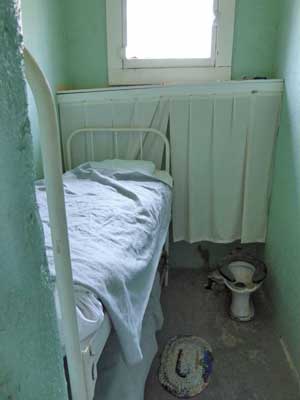

A single ... and double room
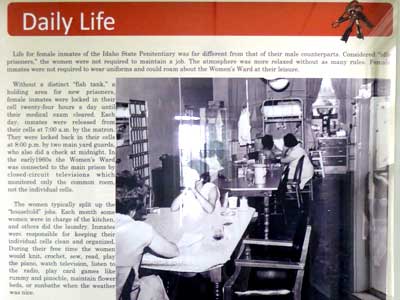

Life for female inmates was very different from that of their male counterparts. They were not required to work; the atmosphere was more relaxed with fewer rules; they didn't have to wear uniforms, and could roam about the ward at their leisure. When not cleaning, cooking or doing laundry, they could knit, sew, read, play piano, watch tv, listen to the radio, play card games, garden or even sunbathe. They even got a small Christmas tree and could decorate the windows.
In the early years, a full-time matron (pictured above, right) was unnecessary. This was a woman who served as a buffer between the female inmates and the all-male staff. She was a guard, escort, teacher, nurse and counselor. After 1905, this was typically the warden's wife.

Most of the stories were simply the humorous actions of bored women. Some were caught whistling at a good-looking man, who happened to be the warden. Others tried hoarding sugar and tea to get the matron in trouble.
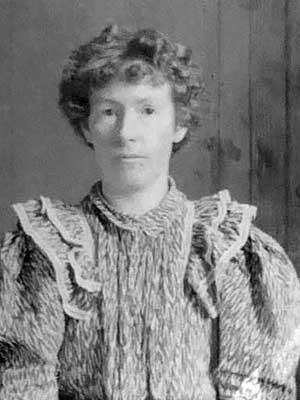

The bigger scandals of Josie ... and Lyda
In 1902, Josie Kensler, while discussing her parole, told her lawyer she was pregnant. Two weeks later, she told him that the warden and the doctor had forced her to take a drug which caused a miscarriage. The two men were arrested, saying there was no truth to the story. She later confessed she had lied, thinking it would help her get a pardon. However, the doctor had indeed given her a "soothing tonic" which had made her sick for days. It was decided that even though she hadn't been pregnant, it was likely he had given her something as if she had been. He was fined.
In 1923, two years into her sentence, it was rumored that Lyda Southard had had a child in prison. Then in 1931, she escaped during the night, supposedly with the help of a former male convict. She was currently serving nearly 20 years for the murder of her 4th husband, the longest time of any female inmate. She was found 15 months later, married to her 5th husband.

A botched escape attempt

In 1948, two women (Verna, a 17-year-old murderer, and Margaret, her 21-year-old cellmate) worked for days to loosen a bar on their cell window. Using kindling and timber from the coal box and made a ladder to climb the wall. They walked 2 miles into Boise then hitchhiked to Caldwell. They had left a note saying they'd be back soon. They visited Verna's mom then surrendered the next morning, treating the escape as fun and a great prank.


Woffie started forging checks as a teenager. When she was 21, she stole blank checks from a job. She bought new dresses for $110. She served 4 months.
Dorothy wrote numerous false checks all over the US, gaining the interest of the FBI in 1931. She was eventually caught in Boise and served 1 year 2 months. She quickly began writing bogus checks again.


Mamie admitted to receiving stolen items from her husband and son, who had robbed local residents and businesses. She was sentenced to 6 months - 3 years. However, when she arrived at the penitentiary with her 1-month-old daughter, the warden placed the baby in a children's home, explaining the one-room ward already had 5 inmates and was unsafe for a child. Public outrage caused her to be released after 5 days.
Ida claimed a man convinced her to hire a team of horses and drive them to Washington to sell. But then he didn't show up and she got the blame. She was one of the earlier residents and served only 3 months.


Following her divorce, Leora went to live with Hugh, his wife and their 9 children, tending potato and beet fields. After 5 years, the two oldest children claimed she was sleeping with their father. It was very likely a consensual relationship on the part of all 3 adults. She served 1 month and 13 days.
Remember Carl J. van Moulken, the 52-year-old who threatened young Daisy to marry him? This is THAT Daisy. She served less that a year before being pardoned on the condition that she leave Idaho. Her life of crime continued, however, with convictions for theft, vagrancy and forgery.
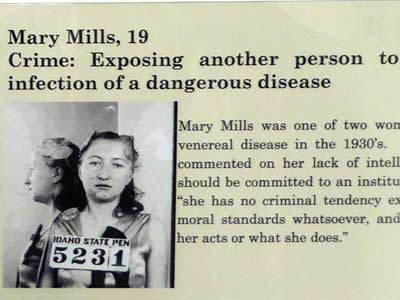
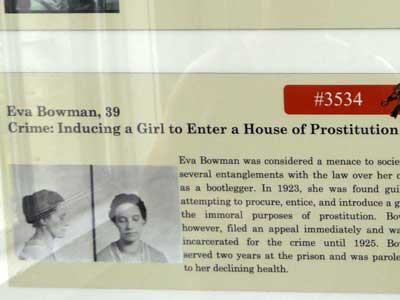
Mary was one of two women convicted for spreading a venereal disease in the 1930s. Her prosecutor commented on her lack of intelligence and argued she should be committed to an institution. Note in her file state that she has no moral standards whatsoever and no compunction as to her acts.
Eva was considered a menace to society during her career as a bootlegger. In 1923, she was found guilty of attempting to procure and entice a girl into prostitution. She filed an appeal and wasn't incarcerated until 1925. She served 2 years but was paroled due to her declining health.


In 1953, Lena served time for providing an abortion to a young woman. Desperate women came to her either for the procedure or for help finding homes for their illegitimate children. One of the oldest female inmates, she was released less than a year later.
Hannah was convicted of Possession of Intoxicating Liquor after Prior Conviction in 1922. She tried to bribe the deputies with $50 to replace the moonshine with water.


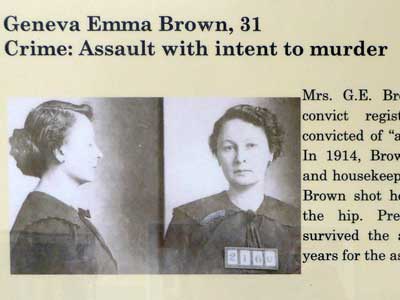
In 1933 while at a 4th of July celebration, Marjory saw her husband get into a brawl with another man. Fearing him to be in danger, she pulled a knife from her purse and stabbed the man in the back. She was sentenced 6 months - 2 years, but only served 4 months 18 days.
In 1914, Geneva worked as a chambermaid at a hotel. She shot a female guest in the hip. The woman survived and Geneva served 2 years for assault.


In 1936, a 4-year-old girl was found dead in her bed. The child was covered with bruises, cuts and burns. The father was found guilty as was his housekeeper, Lela. Both claimed marks like that were "normal" for a child of that age. A neighbor stated seeing the girl tied to a fence while being verbally abused by Lela.
Lula worked as a foster mom to help support her family of 7. She took in a 4-year-old girl who Lula claimed would never behave. So she looped a 22-pound chain around the girl's neck and suspended it from the ceiling. The girl quickly choked to death. In her confession, Lula claimed she'd heard that large chains couldn't injure anyone. She was granted a full pardon in 1978 after serving 3 years.


While leaving a tavern, Grace ran over a man. Twice! The state claimed she was intoxicated. Her defense maintained she was a poor drive who lost control of the large car. She was sentenced to 10 years but appealed. It failed but she only ended up serving 2 years.
Edna had already had many criminal offenses... drunkenness, disturbing the peace and even prostitution. She fought with her live-in boyfriend. She claimed he hit her, took money from her purse and spent it on another woman. While he was sleeping, she threw a pot of hot lye on him while in a drunken rage. She served 2 years. 40 days after her release, she was back in prison for having fatally stabbed another woman during an argument. She served nearly 3 years of an 8 year sentence.

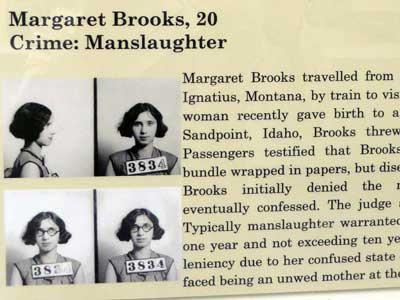
In 1952, Josephine served 3 years for the death of her ex-husband. She claimed he had stolen $20 from her purse while she was working as a waitress at a club. When she went to confront him, he began to beat her. She shot him but he continued to hit her until she fled. He died 2 weeks later in a hospital.
Margaret was unmarried but had recently given birth. While traveling on a train, she threw the baby from it. She had disguised the infant as a bundle of papers. She eventually confessed. She was only sentenced to 1 year since the judge acknowledge the pressure she faced from being an unwed mother.


Ethelyn ended up punishing her 3-year-old stepson to death. She first held him upside down by his feet and repeatedly dunked his head in an irrigation ditch, intentionally hitting his head against a foot bridge. Upon her sentence of 25 years - life, she screamed and collapsed in the courtroom, apparently from nervous hysteria. But after 2 years, she became 'normal' again and was released.
We've also read about Rebecca before! She and her husband, Jesus Mehan (J.M.) were involved in the shooting of a man (her ex-lover) at a Mexican dance. She was released and deported.


At the age of 15, Alwilda was determined to marry Myrle, who was 10 years older than she was. Her father refused to consent to the marriage so they plotted to kill him. Myrle shot him, killing him instantly. He then beat the man's dog to death after it wouldn't stop barking. Alwilda showed little remorse, claimed the entire plan was her idea, and only cried over the dog. They were both sent here. She was the youngest female inmate.
In 1925, Carl died of intestinal influenza. Five months later, officials exhumed his body and fount traces of arsenic in his organs. Mary, his wife and recipient of his life insurance policy, was sentenced to 15 years. After just 3 months, she set fire to several pieces of furniture and suffered a violent nervous attack. She was sent to the asylum where she served out the rest of her sentence.


Elizabeth's husband often threatened her and beat their children. In 1939, she served him coffee with strychnine. He had his stomach pumped and lived. She filed for divorce in 1947 and moved away. Two years later, at the request of her daughter, she returned. Two days after returning, she killed her ex-husband by poisoning him again with strychnine, this time in his whiskey. She was released in 1962 after serving 13 years.
More on Lyda... She was convicted of murder of her 4th husband. Her three previous husbands, a brother-in-law and her child also all died under similar, mysterious circumstances. An autopsy showed a lethal dose of arsenic in his system and it was agreed that the other deaths were probably of the same cause.
Around the compound were a few houses.


Built in 1911, unmarried guards lived here. It was considered necessary to have extra guards available 24/7 in case of emergency. Free room and board help compensate for low wages and dangerous living conditions. ... The bishop's house

The warden's house was completed in 1902. It contained 8 rooms and a basement. By using inmate labor, it only cost $3,100 to build... saving almost $4,000.
We left Boise and stopped at a fun Mexican Restaurant called Mi Casa on the way back to Caldwell.






The portions were massive!
return • continue

